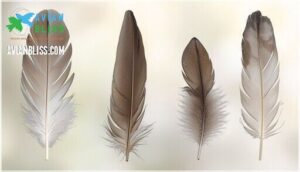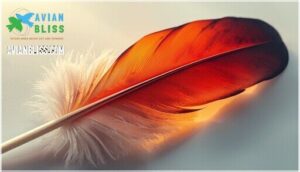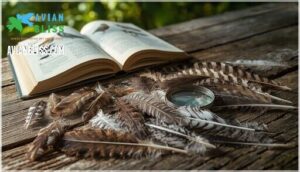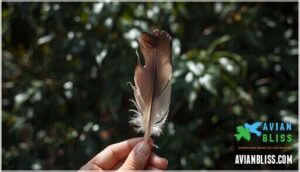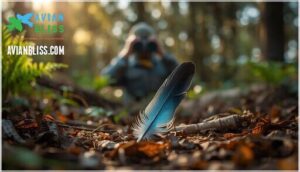This site is supported by our readers. We may earn a commission, at no cost to you, if you purchase through links.

Bird feather identification turns these mystery clues into answers. Each feather carries markers that point to its owner. The shaft’s thickness matters, and color patterns tell stories. Even tiny barbs hold secrets about the bird’s life.
Learning to read these signs opens a new way to see the birds around you. You’ll spot details you walked past before. The feathers scattered in your yard become a field guide written by the birds themselves.
Table Of Contents
- Key Takeaways
- Essential Components of Bird Feather Identification
- Step-by-Step Guide to Identifying Bird Feathers
- Common Challenges in Bird Feather Identification
- Differentiating Feathers From Various Bird Groups
- Legal Considerations for Collecting and Possessing Feathers
- Advanced Techniques in Bird Feather Identification
- Citizen Science and Feather Identification Projects
- Frequently Asked Questions (FAQs)
- How do I identify a bird feather?
- What is a bird feather guide?
- How do you identify a bird?
- How do I find out what feather I found?
- Is there an app that identifies bird feathers?
- How can you tell the difference between a hawk and owl feather?
- Can I keep feathers I find?
- How do feather colors change over time?
- Can bird species be identified from single feathers?
- What tools aid in microscopic feather analysis?
- Conclusion
Key Takeaways
- Feather identification relies on four key components: feather type (flight, contour, down, or sensory), anatomical structure (calamus, rachis, barbs, and barbules), color patterns and markings, and size/shape variations that reflect each bird’s lifestyle and habitat.
- The Migratory Bird Treaty Act protects over 1,000 species, making it illegal to possess most native bird feathers without federal permits—even naturally molted ones—though you can legally keep feathers from non-native species like House Sparrows and European Starlings.
- Advanced identification techniques like DNA testing, microscopic analysis of barbule structures, spectrophotometry for UV-invisible color patterns, and isotope analysis can achieve 96-100% accuracy when visual comparison methods fall short.
- Citizen science contributions through feather databases, online forums, and collaboration with research institutions directly support conservation efforts by providing over 3,000 verified records annually that track migration patterns, species distribution, and biodiversity shifts.
Essential Components of Bird Feather Identification
You can’t identify a feather without knowing what to look for. The key is breaking down each feather into four basic components that work together like pieces of a puzzle.
Let’s walk through what makes every feather unique.
Feather Types and Their Characteristics
Bird feathers fall into distinct categories that you can learn to recognize. Four main types of bird feathers serve specialized roles. Flight feathers show pronounced asymmetry with shorter leading edges that prevent twisting during flight. Contour feathers overlap like roof shingles and create your bird’s sleek outline while channeling airflow. Down feather density varies by species and traps air for warmth. Semiplumes offer insulation between larger feathers. Keratin proteins are essential to feather composition.
Here’s what to look for:
- Flight feathers: Asymmetrical shape with stiff shafts attached to wing bones
- Contour feathers: Overlapping arrangement with waterproof tips and downy bases
- Down feathers: Loose fluffy structure with minimal central shaft
- Sensory feathers: Filoplumes monitor feather position while bristles protect eyes and beak
Understanding feather characteristics turns mystery finds into clear identifications.
Feather Structure and Anatomy
Understanding feather structure and anatomy helps you identify birds with confidence. Each feather has three main parts. The calamus anchors the feather in the skin follicle. The rachis extends upward and holds barbs that branch out to form the vane. Barbule function depends on tiny hooklets that zip barbs together. Plumulaceous regions near the base trap air for insulation while pennaceous tips create smooth aerodynamic surfaces. Mechanical adaptations include a foam-like core that reduces weight without sacrificing strength. Like human hair, feathers are primarily made of keratin protein.
| Part | Location | Function |
| Calamus | Hollow base | Anchors feather in skin follicle |
| Rachis | Central shaft | Holds barbs and creates feather shape |
| Barbs | Extending laterally | Branch from rachis to form vane surface |
| Barbules | On each barb | Lock together with hooklets for vane formation |
Color Patterns and Markings
Look closely at a feather and you’ll see nature’s art gallery at work. Color patterns and feather markings aren’t random—they reveal whether a bird hides from predators using Camouflage Techniques or attracts mates through Sexual Selection. Structural Coloration creates iridescent blues and greens without pigment. Seasonal Molt changes Plumage Patterns throughout the year.
Study these four features:
- Base feather color (from melanin or carotenoids)
- Barring, spots, or stripes across the vane
- Iridescence from light-reflecting structures
- Specialized markings like eye-spots or bands
These color variations act like fingerprints for identification.
Size and Shape Variations
Feather length tells you a lot about a bird’s lifestyle. Body mass drives feather sizes—waterfowl sport contour feathers between 7 and 12 centimeters while raptors reach up to 25 centimeters.
Flight adaptations shape feather structure too. Soaring birds have broader feathers with wider rachises. Fast-flapping species show narrower shapes with denser barbs.
Climate influence matters as well. Temperate birds grow feathers faster than tropical species. Species variation in feather measurement helps you narrow down possibilities quickly.
Step-by-Step Guide to Identifying Bird Feathers
Identifying a feather you’ve found takes a systematic approach. You’ll need to observe specific features in a logical order to narrow down the possibilities.
The following steps will walk you through the process from initial examination to confirmed identification.
Examining Feather Color and Pattern
Color patterns reveal the most about a feather’s origin. Start by noting whether pigment types like melanin create black or brown tones, or if carotenoids produce reds and yellows. Structural colors, such as blues and iridescent sheens, result from light scattering in the feather’s microscopic layers.
Pattern formation—spots, bars, or streaks—helps narrow your options. Don’t forget UV reflectance, invisible to you but critical for birds.
Environmental influences like wear can fade color variations over time, so assess the feather’s condition alongside its hues for accurate feather pattern analysis.
Analyzing Feather Shape and Structure
Shape reveals function. Start with rachis morphology—the central shaft that makes up 40 to 60 percent of the feather. A straight rachis suggests a primary flight feather. A curved one indicates a tail feather.
Check vane asymmetry next. If the rachis sits closer to one edge, you’re holding a flight feather built for aerodynamics. Symmetrical vanes point to body contour feathers. Notice barb asymmetry too. Barbs that grow longer near the base create natural camber for stable flight.
Measuring Feather Size
Measurement accuracy separates guesswork from solid identification. You need precise numbers to match feathers against established feather databases and wing morphometry records.
Here’s how to measure correctly:
- Total length – Place the feather flat and measure from the insertion point to the tip using calipers for ±0.1 mm accuracy.
- Vane width – Record the widest point across both vanes combined.
- Shaft diameter – Measure at the midpoint to distinguish feather types.
Lab-grade calipers beat flat rulers every time. They eliminate observer variability that can skew your data by several millimeters. Electronic versions reduce human error across multiple measurements. This precision matters when you’re comparing your find against identification tools and feather characteristics in reference collections.
Comparing With Reference Materials
You’ll match your feather against three powerful identification tool types.
The Feather Atlas and other digital tools let you cross-reference color and size through database cross-referencing systems that narrow 438 species to fewer than 10 matches. AI-assisted systems now achieve over 93% accuracy by comparing patterns automatically.
For tougher cases, microscopic comparisons reveal shaft diameter differences, while protein composition analysis and DNA references confirm tricky identifications when field guides fall short.
Consulting Expert Sources
When field guides and digital tools fall short, expert collaboration through forensic ornithology labs provides the answer. The Smithsonian Feather Identification Lab processes over 10,000 bird identification cases yearly using microscopic analysis and DNA testing.
You can submit feather samples to these labs or consult ornithology training programs for guidance. Reference materials from museum collections help confirm tricky bird species identifications that challenge even experienced observers.
Common Challenges in Bird Feather Identification
Even experienced birders hit roadblocks when identifying feathers in the field. Worn edges can hide key markings, and similar species share nearly identical patterns. Seasonal changes and juvenile plumage add layers of complexity you need to work through.
Here are the most common obstacles you’ll face and how to tackle them.
Dealing With Worn or Damaged Feathers
When you find damaged feathers, don’t toss them aside—feather wear and aging signs can sharpen your identification accuracy. Look for frayed barbs and faded pigments caused by UV exposure or environmental stress. These clues reveal the bird’s molt stage and life history.
Microscopic detection shows barbule damage patterns that help assess feather condition. Even worn specimens offer valuable identification data when you know what to look for.
Distinguishing Similar Species’ Feathers
Telling similar species apart takes a sharp eye. You’ll need to look at tiny details that make each bird unique. Here’s what works:
- Keratinization levels and rachis diameter – Raptor feathers are denser than corvid feathers, and the shaft width varies up to 25% between Cooper’s and sharp-shinned hawks.
- Barbule count – Count the tiny branches per millimeter. Owl species can differ by 10 barbules.
- Wing asymmetry – Hawks show 0.78 ratios while falcons hit 0.65.
- Pigment analysis – Color patterns reveal carotenoid versus melanin origins.
These feather identification techniques turn guesswork into solid species identification.
Accounting for Seasonal Plumage Variations
Seasonal plumage changes complicate your ID work because up to 60% of temperate birds shift colors between breeding and non-breeding seasons. Males sport brighter breeding plumage, while molt cycles fade those same feathers months later.
Urbanization effects reduce these variations in city birds, but rural species show dramatic seasonal dimorphism.
Genetic influence controls whether colors come from carotenoids or structural pigments, so timing matters when you’re matching feathers to reference photos.
Identifying Juvenile Bird Feathers
Juvenile bird feathers can stump even seasoned identifiers. Young birds grow their first set of feathers—called juvenal plumage—all at once after hatching. These feathers look fluffier and more tapered than adult feathers. They show streakier colors and wear faster because the shafts have fewer protective layers. Recognizing diagnostic features helps with age classification and feather analysis during seasonal changes and molting periods.
- Pointed tips – Juvenile feathers taper to narrow points instead of rounded ends
- Looser texture – Barbules don’t interlock as tightly, creating a softer appearance
- Mottled patterns – Streaky or mud-splattered markings provide camouflage for young birds
- Rapid wear – Feather wear accelerates due to weaker shaft structure
- Molt limits – Look for interruptions where juvenile molt patterns stop and formative plumage begins
Differentiating Feathers From Various Bird Groups
Once you start comparing feathers across different bird groups, the differences become obvious. Raptors, waterfowl, songbirds, and shorebirds each show unique patterns that reflect how they live and move. Here’s what sets each group apart.
Raptor Feather Characteristics
Raptor feathers tell stories of power and precision. When you’re identifying bird feathers from hawks, eagles, and falcons, you’ll notice flight feather asymmetry right away. Each primary feather has a narrow leading edge and a wider trailing edge. This design reduces noise during hunting and boosts hunting efficiency.
Juvenile feather quality differs from adults—young raptors grow softer feathers that wear faster. Adults develop stiffer, more durable feathers through their molt cycle timing.
Look for these key feather characteristics:
- Horizontal camouflage banding across tail and wing feathers
- Terminal dark bands near feather tips for species identification
- Length ranging up to 25 centimeters in large raptors
- Rigid outer primaries with interlocking barbs for silent flight
Waterfowl Feather Features
Waterfowl feathers reveal nature’s engineering at its finest. You’ll spot waterproofing mechanisms right away—dense barbules create surfaces that shed water like magic. The speculum patterns on secondary wing feathers flash iridescent blues and greens unique to each bird species. Check the shaft underside for the tegmen, a waxy patch that’s your go-to identification tool for waterfowl.
| Feature | Duck Species | Goose Species |
|---|---|---|
| Feather density | 30% higher than songbirds | High body concentration |
| Plumage dimorphism | Males show 12-18% larger pigmented areas | Minimal between sexes |
| Primary count | 10-12 secondaries typical | Similar wing structure |
| Body feather mass | 55.5% of total plumage | Dominant percentage |
| Down insulation | 11% of plumage weight | Critical thermal layer |
Feather characteristics include tightly packed barbs and lipid coatings that maintain water resistance. Your feather identification skills improve when you recognize these structural details.
Songbird Feather Identification
Songbird feathers pack remarkable diversity into compact forms. Primary feathers generally measure 50–120 mm and weigh under 0.2 g—perfect for agile movement through branches. Their diagnostic features include symmetrical vanes and rounded tips that separate them from raptors or waterfowl.
Feather pigmentation reveals age and sex: males show 40% brighter colors during breeding season. Molting patterns follow predictable sequences that help with bird feather identification.
Environmental influences like elevation increase downy barb density by 10–15% for insulation. Genetic variability affects replacement timing across local species, making feather identification techniques essential for distinguishing similar songbird feather characteristics.
Shorebird and Wader Feather Traits
Shorebird feathers exhibit three distinct features that simplify bird identification. Their flight feathers are long and narrow, designed for streamlining during migrations spanning 10,000 km. Plumage transitions from breeding browns to winter grays aid in feather identification across seasons. Functional adaptations, such as reinforced tips, resist saltwater wear, while molt patterns differ between species.
- Species markers: Juvenile scapular feathers appear rounded and faded compared to adults
- Color shifts: Western Sandpipers change from rusty breeding tones to plain gray
- Structural traits: Asymmetric primaries and waterproof contour layers define these bird species
Legal Considerations for Collecting and Possessing Feathers
Finding a feather is exciting, but you need to know the rules before you keep it. Federal law protects most bird species in North America and makes it illegal to possess their feathers without proper permits.
Understanding these regulations helps you collect responsibly and avoid serious legal trouble.
Migratory Bird Treaty Act Regulations
The Migratory Bird Treaty Act controls feather collection through federal regulations that protect approximately 1,107 migratory bird species. You can’t legally possess feathers from protected species without proper permit requirements from the U.S. Fish and Wildlife Service. Enforcement mechanisms include fines up to $15,000 and six months imprisonment per violation.
Recent legislative actions have shifted incidental take protections, affecting compliance failures and wildlife law enforcement. Understanding these legal aspects of feather collection helps you follow ethics and legal considerations while pursuing your interest in bird identification.
Protected Species and Restricted Feathers
The MBTA protects over 1,000 species, making most native bird feathers illegal to possess. Federal regulations under wildlife law enforcement treat even naturally molted feathers as restricted items. Understanding which species are protected helps you avoid MBTA violations and aids conservation impact through proper ethics and legal considerations.
Key protected groups include:
- Hawks and owls – all raptor feathers fall under strict wildlife protection
- Songbirds and waterfowl – native species require permit acquisition for legal possession
- Eagles and herons – feather trafficking penalties reach $50,000 with Native exemptions for ceremonial use
Proper Documentation and Permits
You’ll need a Federal permit from the U.S. Fish and Wildlife Service to legally possess protected bird feathers for research documentation or educational purposes. State authorization may also apply depending on your location.
Maintain detailed recordkeeping procedures, including dates, species, and collection sites. For international transport, secure Form 3-200-6 and comply with CITES requirements.
Proper photography and digital documentation support responsible handling and documentation while meeting legal guidelines for collecting feathers and ethics and legal considerations.
Ethical Guidelines for Feather Collection
Collecting feathers ethically means respecting wildlife protection and conservation ethics above all else. You can’t just grab any feather you find without understanding legal guidelines for collecting feathers and bird welfare concerns. Follow these principles for responsible handling and documentation:
- Collect only naturally molted feathers from non-protected species
- Photograph feathers where you find them before picking them up
- Avoid nesting sites and sensitive habitats entirely
- Follow biosecurity measures to prevent disease spread
Public education about Indigenous rights and legal restrictions helps everyone understand proper collection methods.
Advanced Techniques in Bird Feather Identification
Sometimes basic identification methods won’t cut it. When you’ve got a tricky feather that standard field guides can’t crack, specialized lab techniques step in to provide definitive answers.
Here are four powerful tools that take feather identification beyond what your eyes can see.
Microscopic Analysis of Feather Structure
Under a microscope, you’ll see the real magic of feather structure. Barbs and barbules reveal keratin nanostructure details that separate bird orders with over 90% accuracy.
Forensic microscopy at 100–400× magnification exposes barbule morphology—node density and hooklet patterns unique to each family.
You’ll spot structural color from nanostructures spaced 150–300 nanometers apart. These taxonomic applications turn tiny features into powerful identification tools for feather anatomy analysis.
DNA Testing for Species Confirmation
When microscopy shows its limits, DNA extraction from feather barbs opens a new frontier in species identification. You can confirm avian species with over 98% accuracy using genetic markers like the COI gene—a standard DNA barcode. Just two barbs from the calamus yield enough mitochondrial DNA for wildlife forensics. Here’s what makes feather analysis powerful:
- Lab advancements now deliver results in 1–2 days
- Direct PCR cuts costs by 30% without DNA purification
- Portable labs provide field results in 60–90 minutes
- Conservation applications track illegal wildlife trade
- Forensic protocols identify trafficked birds for enforcement
Feather identification through DNA testing aids endangered species verification and aircraft strike investigations with minimal sample sizes.
Using Spectrophotometry for Color Analysis
Spectral data from light reflectance measurements reveal color patterns invisible to the human eye. Using spectrophotometry, you can analyze feather color across wavelengths from 300 to 700 nanometers, including ultraviolet light that birds perceive but humans cannot. Field spectrophotometry allows you to scan feathers without removing them from specimens, while hyperspectral imaging captures pixel-level color patterns across the entire feather surface. Color modeling converts raw measurements into brightness, saturation, and hue values.
Here’s what this technology reveals:
| Feature | What It Shows You |
|---|---|
| Plumage dimorphism | Subtle male-female color differences invisible to human vision |
| Structural vs. pigment colors | Whether color comes from feather nanostructures or chemical pigments |
| Species differences | Objective measurements that separate similar-looking birds |
| Evolutionary patterns | How feather color drives mate selection and species recognition |
To ensure accurate measurements, position a fiber-optic probe at a 45-degree angle to minimize glare. Conduct three scans per feather to maintain accuracy within 2% variance. Note that underlying white feathers can boost brightness readings by up to 35%, so account for feather layers during analysis.
Isotope Analysis for Migration Studies
Through isotope analysis, you can trace bird migration by examining hydrogen, carbon, nitrogen, and oxygen locked in feathers during molt. These chemical markers reveal where a bird grew its plumage, linking individuals to specific breeding or wintering sites. Calibration equations improve accuracy, explaining up to 50% of variance between feather and precipitation values.
Tracking integration with geolocators and Bayesian models reduces assignment errors by 10%, though isotope limitations like east-west resolution gaps remain. Regional variations in environmental factors challenge species identification, but future directions promise 15% better precision through high-resolution libraries.
Consider these factors:
- Hydrogen isotopes indicate geographic origins with residual errors near 18.3‰
- Dual-isotope methods narrow origin zones by 40%
- Environmental factors introduce ±20‰ uncertainty in assignments
Feather analysis now aids disease monitoring and connectivity studies across bird migration routes.
Citizen Science and Feather Identification Projects
You can do more than just identify feathers on your own. Citizen science projects let you share your findings and learn from a wider community of bird enthusiasts.
Here’s how you can get involved and make your observations count.
Contributing to Feather Databases
You can push bird science forward from your backyard. Online feather databases like Featherbase and the U.S. Fish and Wildlife Service’s Feather Atlas rely on image database submissions from everyday enthusiasts.
Snap a clear photo with a ruler for scale. Record location and date. Upload to reputable platforms that use image verification methods to maintain data accuracy.
Your contributions support collaborative data sharing that tracks migration patterns and species health. Database accessibility has grown considerably—over 2 million feather records now exist thanks to citizen science impact and proper data submission ethics.
Participating in Online Identification Forums
Joining online feather identification forums connects you with experts who can solve your toughest ID puzzles. Over 50% of forum discussions now include photo submissions for species verification. These platforms offer real benefits:
- Community Verification Methods reduce misidentification by 18% through expert review
- Learning Feather Anatomy improves—45% of users master terminology within three months
- Mobile Identification Tools make field uploads easy—62% of IDs happen via smartphone
- Forum ID Accuracy reaches high levels when cross-referenced with online feather databases
- Conservation Data Impact adds 3,000+ verified records annually to global collections
You’ll find response times average just 24 hours on active platforms. Share clear photos with measurements and location details.
Your feather identification techniques strengthen as the community helps you master identifying bird species through practical feedback and feather identification resources.
Collaborating With Researchers and Experts
Working with ornithology experts provides opportunities you can’t access alone. The Smithsonian’s Feather Identification Lab trains specialists through internships and visiting researcher programs. Over 20 academic institutions participate annually in these wildlife forensics projects. You’ll gain hands-on experience in forensic ornithology methods that professionals use daily.
Here’s how to connect with researchers:
- Contact the National Fish and Wildlife Forensics Laboratory for expert consultations on protected species
- Join research partnerships through Cornell Lab of Ornithology or similar institutions offering training programs
- Participate in data sharing initiatives that support avian biology studies and conservation efforts
These collaborations strengthen your identification skills while contributing real value to ornithological studies.
Reporting Rare or Unusual Feather Findings
Finding a rare feather feels like striking gold. Your discovery could reshape what scientists know about bird species distribution and wildlife identification patterns. When you document unusual feathers properly, you’re joining a citizen science effort that fuels conservation research nationwide.
Report your findings through eBird or local Rare Bird Alerts. Include precise details about color patterns, size measurements, and regional variations. Photographs from multiple angles help verification committees confirm species identity. DNA forensic analysis can validate findings when visual traits alone don’t provide certainty.
The Florida Ornithological Society’s records committee rejects 10-15% of submissions due to poor data quality. Don’t let yours be one of them. Detail how you ruled out similar species during your birdwatching observations.
| Documentation Element | Why It Matters |
|---|---|
| Pattern measurements | Distinguishes similar species |
| Habitat context | Confirms regional presence |
| Multiple photos | Allows forensic analysis review |
| Comparison notes | Strengthens verification accuracy |
Legal requirements under the Migratory Bird Treaty Act mean you can’t keep protected feathers without permits. Document thoroughly, report promptly, then return feathers to nature. Your careful work has real conservation significance for tracking biodiversity shifts across North America.
Frequently Asked Questions (FAQs)
How do I identify a bird feather?
You can identify a bird feather by examining its color patterns, shape, size, and structure. Over 10,000 bird species exist worldwide, so start with visual identification tips like checking for barred or spotted patterns.
Compare your findings with online resources like the Feather Atlas to narrow down possibilities and avoid common mistakes.
What is a bird feather guide?
A bird feather guide is a specialized resource with photos, diagrams, and descriptions that help you identify feathers by examining their anatomy, color patterns, size, shape, and species-specific traits.
How do you identify a bird?
You look at several features together. Visual cues like color and markings narrow down bird species identification. Habitat clues and behavior patterns provide context. Bird songs and flight styles offer additional confirmation. Feather characteristics and identification help when examining found feathers.
How do I find out what feather I found?
Picture yourself holding a mystery feather you just discovered. Start by noting its shape, size, and color patterns. Snap a clear photo and compare it with online feather identification tools like the Feather Atlas.
Measure the rachis length and examine barb patterns closely. Check local regulations before keeping it—many feathers are legally protected.
Is there an app that identifies bird feathers?
Yes. Several apps help you identify feathers using photos. Merlin Bird ID and iNaturalist support image uploads and connect you with expert communities. Apps like Identifier: Feather use AI for instant recognition.
Photo quality matters—clear, well-lit images improve accuracy across all identification tools.
How can you tell the difference between a hawk and owl feather?
You’ll notice hawk feathers have stiffer rachis and prominent barring for aerodynamic power.
Owl feathers feature serrated leading edges, velvety texture, and fringed trailing edges that enable their signature silent flight through sound dampening adaptations.
Can I keep feathers I find?
Finding a feather sparks curiosity, but federal law decides what you can keep. The Migratory Bird Treaty Act prohibits possessing feathers from over 1,093 protected species—even naturally molted ones.
However, you can legally collect feathers from non-native species like House Sparrows, European Starlings, and domestic poultry. This conservation rationale protects wild populations from illegal trade.
Always verify species before collecting to avoid enforcement penalties.
How do feather colors change over time?
Feathers don’t stay bright forever. UV radiation breaks down pigments, especially carotenoids, causing rapid fading within weeks. Molting replaces worn feathers annually, restoring vibrancy temporarily.
Abrasion from daily use dulls structural colors, while dietary pigments determine how vivid new growth becomes after each molt cycle.
Can bird species be identified from single feathers?
You can identify a bird species from a single feather with high accuracy. Genetic identification methods like DNA testing achieve 96-100% success rates. Microscopic analysis reveals diagnostic barbule structures and shaft characteristics.
Visual comparison using reference collections like the Feather Atlas narrows possibilities through color, pattern, and size matching.
The feather identification process combines these techniques for reliable species identification.
What tools aid in microscopic feather analysis?
You’ll rely on stereomicroscopes for three-dimensional views and compound light microscopes for magnification up to 1500x.
Digital cameras capture barbule density and keratin details. Software like ImageJ measures melanin granules.
Darkfield and polarized illumination methods reveal nanostructures in feather analysis.
Conclusion
What’s the real value in picking up that single feather? It’s your direct line to understanding the birds sharing your space. Bird feather identification transforms scattered clues into concrete knowledge about species around you.
You’ve learned the markers that matter: shaft width, color bands, barb structure, and seasonal changes. Each feather you examine sharpens your eye for the next one. The practice builds your skills until recognition becomes second nature. Now those mystery feathers aren’t puzzles anymore—they’re messages you can read.

